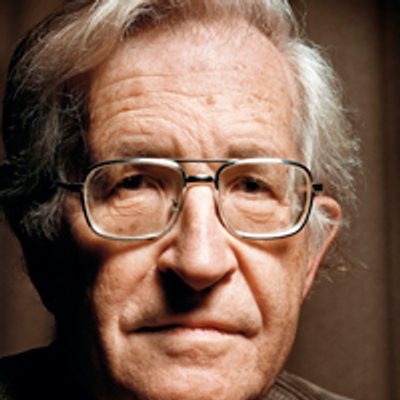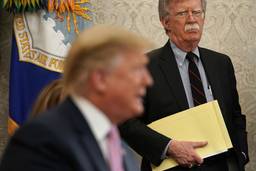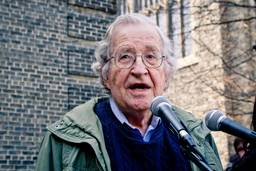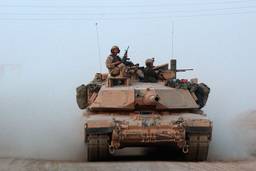Gaza Under Assault
The images of bombardment have left Israel few remaining shreds of credibility.
Noam Chomsky
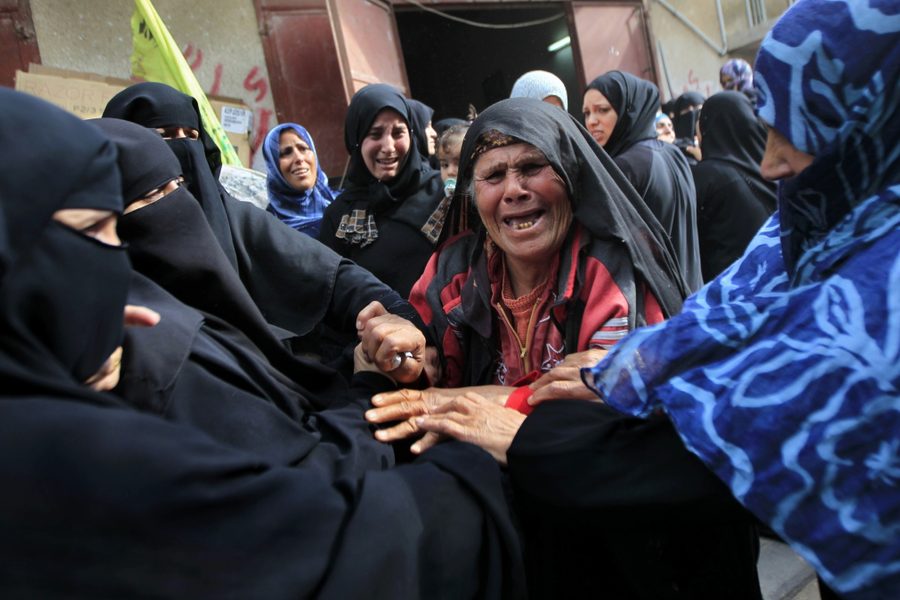
An old man in Gaza held a placard that read: “You take my water, burn my olive trees, destroy my house, take my job, steal my land, imprison my father, kill my mother, bombard my country, starve us all, humiliate us all, but I am to blame: I shot a rocket back.”
The old man’s message provides the proper context for the latest episode in the savage punishment of Gaza. The crimes trace back to 1948, when hundreds of thousands of Palestinians fled from their homes in terror or were expelled to Gaza by conquering Israeli forces, who continued to truck Palestinians over the border for years after the official cease-fire.
The punishment took new forms when Israel conquered Gaza in 1967. From recent Israeli scholarship (primarily Avi Raz’s The Bride and the Dowry: Israel, Jordan, and the Palestinians in the Aftermath of the June 1967 War), we learn that the government’s goal was to drive the refugees into the Sinai Peninsula — and, if feasible, the rest of the population too.
Expulsions from Gaza were carried out under the direct orders of Gen. Yeshayahu Gavish, commander of the Israel Defense Forces Southern Command. Expulsions from the West Bank were far more extreme, and Israel resorted to devious means to prevent the return of those expelled, in direct violation of U.N. Security Council orders.
The reasons were made clear in internal discussions immediately after the war. Golda Meir, later prime minister, informed her Labor Party colleagues that Israel should keep the Gaza Strip while “getting rid of its Arabs.” Defense Minister Moshe Dayan and others agreed.
Prime Minister Levi Eshkol explained that those expelled could not be allowed to return because “we cannot increase the Arab population in Israel” — referring to the newly occupied territories, already considered part of Israel.
In accord with this conception, all of Israel’s maps were changed, expunging the Green Line (the internationally recognized borders) —though publication of the maps was delayed to permit Abba Eban, an Israeli ambassador to the UN, to attain what he called a “favorable impasse” at the General Assembly by concealing Israel’s intentions.
The goals of expulsion may remain alive today, and might be a factor in contributing to Egypt’s reluctance to open the border to free passage of people and goods barred by the U.S.-backed Israeli siege.
The current upsurge of U.S.-Israeli violence dates to January 2006, when Palestinians voted “the wrong way” in the first free election in the Arab world.
Israel and the U.S. reacted at once with harsh punishment of the miscreants, and preparation of a military coup to overthrow the elected government — the routine procedure. The punishment was radically intensified in 2007, when the coup attempt was beaten back and the elected Hamas government established full control over Gaza.
Ignoring immediate offers from Hamas for a truce after the 2006 election, Israel launched attacks that killed 660 Palestinians in 2006, most of whom were civilians (a third were minors). According to UN reports, 2,879 Palestinians were killed by Israeli fire from April 2006 through July 2012, along with several dozen Israelis killed by fire from Gaza.
A short-lived truce in 2008 was honored by Hamas until Israel broke it in November. Ignoring further truce offers, Israel launched the murderous Cast Lead operation in December.
So matters have continued, while the United States and Israel also continue to reject Hamas calls for a long-term truce and a political settlement for a two-state solution in accord with the international consensus that the U.S. has blocked since 1976 when the U.S. vetoed a Security Council resolution to this effect, brought by the major Arab states.
This week, Washington devoted every effort to blocking a Palestinian initiative to upgrade its status at the UN but failed, in virtual international isolation as usual. The reasons were revealing: Palestine might approach the International Criminal Court about Israel’s U.S.-backed crimes.
One element of the unremitting torture of Gaza is Israel’s “buffer zone” within Gaza, from which Palestinians are barred entry to almost half of Gaza’s limited arable land.
From January 2012 to the launching of Israel’s latest killing spree on November 14, Operation Pillar of Defense, one Israeli was killed by fire from Gaza while 78 Palestinians were killed by Israeli fire.
The full story is naturally more complex, and uglier.
The first act of Operation Pillar of Defense was to murder Ahmed Jabari. Aluf Benn, editor of the newspaper Haaretz, describes him as Israel’s “subcontractor” and “border guard” in Gaza, who enforced relative quiet there for more than five years.
The pretext for the assassination was that during these five years Jabari had been creating a Hamas military force, with missiles from Iran. A more credible reason was provided by Israeli peace activist Gershon Baskin, who had been involved in direct negotiations with Jabari for years, including plans for the eventual release of the captured Israeli soldier Gilad Shalit.
Baskin reports that hours before he was assassinated, Jabari “received the draft of a permanent truce agreement with Israel, which included mechanisms for maintaining the cease-fire in the case of a flare-up between Israel and the factions in the Gaza Strip.”
A truce was then in place, called by Hamas on November 12. Israel apparently exploited the truce, Reuters reports, directing attention to the Syrian border in the hope that Hamas leaders would relax their guard and be easier to assassinate.
Throughout these years, Gaza has been kept on a level of bare survival, imprisoned by land, sea and air. On the eve of the latest attack, the WHO reported that 40 percent of essential drugs and more than half of essential medical items were out of stock.
In November, one of the first in a series of hideous photos sent from Gaza showed a doctor holding the charred corpse of a murdered child. That one had a personal resonance. The doctor is the director and head of surgery at Khan Yunis hospital, which I had visited a few weeks earlier.
In writing about the trip, I reported his passionate appeal for desperately needed medicine and surgical equipment. These are among the crimes of the U.S.-Israeli siege, and of Egyptian complicity.
The casualty rates from the November episode were about average: more than 160 Palestinian dead, including many children, and six Israelis.
Among the dead were three journalists. The official Israeli justification was that “The targets are people who have relevance to terror activity.” Reporting the “execution” in the New York Times, the reporter David Carr observed that “it has come to this: Killing members of the news media can be justified by a phrase as amorphous as ‘relevance to terror activity.’ “
The massive destruction was all in Gaza. Israel used advanced U.S. military equipment and relied on U.S. diplomatic support, including the usual U.S. intervention efforts to block a Security Council call for a cease-fire.
With each such exploit, Israel’s global image erodes. The photos and videos of terror and devastation, and the character of the conflict, leave few remaining shreds of credibility to the self-declared “most moral army in the world,” at least among people whose eyes are open.
The pretexts for the assault were also the usual ones. We can put aside the predictable declarations of the perpetrators in Israel and Washington. But even decent people ask what Israel should do when attacked by a barrage of missiles. It’s a fair question, and there are straightforward answers.
One response would be to observe international law, which allows the use of force without Security Council authorization in exactly one case: in self-defense after informing the Security Council of an armed attack, until the Council acts, in accord with the U.N. Charter, Article 51.
Israel is well familiar with that Charter provision, which it invoked at the outbreak of the June 1967 war. But, of course, Israel’s appeal went nowhere when it was quickly ascertained that Israel had launched the attack. Israel did not follow this course in November, knowing what would be revealed in a Security Council debate.
Another narrow response would be to agree to a truce, as appeared quite possible before the operation was launched on November 14.
There are more far-reaching responses. By coincidence, one is discussed in the current issue of the journal National Interest. Asia scholars Raffaello Pantucci and Alexandros Petersen describe China’s reaction after rioting in western Xinjiang province, “in which mobs of Uighurs marched around the city beating hapless Han (Chinese) to death.”
Chinese president Hu Jintao quickly flew to the province to take charge; senior leaders in the security establishment were fired; and a wide range of development projects were undertaken to address underlying causes of the unrest.
In Gaza, too, a civilized reaction is possible. The United States and Israel could end the merciless, unremitting assault, open the borders and provide for reconstruction — and if it were imaginable, reparations for decades of violence and repression.
The cease-fire agreement stated that the measures to implement the end of the siege and the targeting of residents in border areas “shall be dealt with after 24 hours from the start of the cease-fire.”
There is no sign of steps in this direction. Nor is there any indication of a U.S.-Israeli willingness to rescind their separation of Gaza from the West Bank in violation of the Oslo Accords, to end the illegal settlement and development programs in the West Bank that are designed to undermine a political settlement, or in any other way to abandon the rejectionism of the past decades.
Someday, and it must be soon, the world will respond to the plea issued by the distinguished Gazan human-rights lawyer Raji Sourani while the bombs were once again raining down on defenseless civilians in Gaza: “We demand justice and accountability. We dream of a normal life, in freedom and dignity.”
